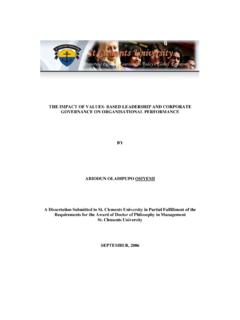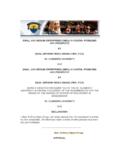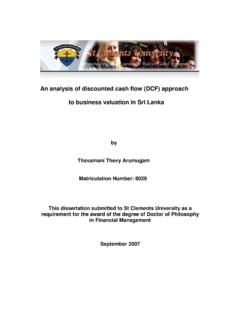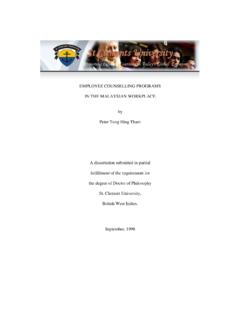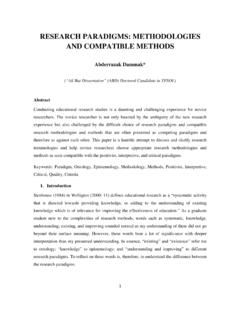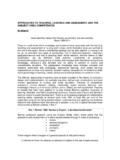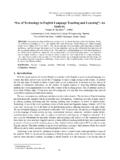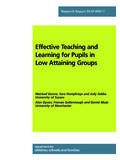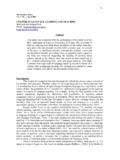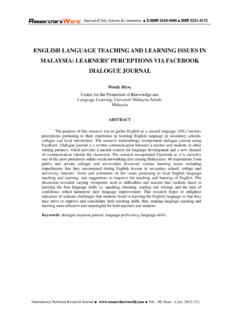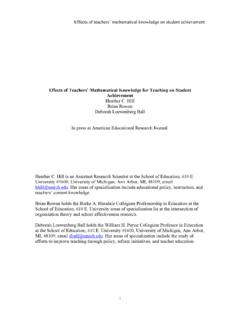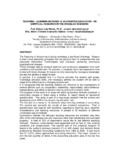Transcription of EFFECTS OF DIFFERENT TEACHING AND LEARNING METHODS
1 EFFECTS OF DIFFERENT TEACHING AND. LEARNING METHODS . SHAIK MOULALI. TABLE OF CONTENTS. 1. INTRODUCTION. Geographical situation of Tanzania Educational system in the country Present method of TEACHING Introduction of computers Micro based LEARNING (MBL). 2. EDUCATION IN TANZANIA A PERSPECTIVE. Historical Background Education During the First Phase Government of Tanzania. The Presidential Commission of Education. Education During the Second Phase Government of Tanzania Outcomes of UPE. Education During the Third Phase Government of Tanzania The Tanzania Education and Training Policy. Formal Education and Training System Vocational Education and Training Non-formal Education and Training Primary Education Development Plan Enrolment Expansion Quality Improvement Capacity Building PEDP Institutional Arrangement Secondary Education Development Plan Access Improvement Quality Improvement Management Reforms Higher Education in Tanzania Brief Description of the Higher Education System in Tanzania Financing Higher Education in Tanzania 1.
2 3. EXISTING USE OF COMPUTERS IN TANZANIA. Deployment of ICT in Tanzania Status of ICT in Tanzania The National ICT Programmes and Projects The Overall ICT Environment in Tanzania Access to ICT Facilities ICT and Education ICT and Society 4. AIM OF STUDY AND RESEARCH APPROACH. Science TEACHING Computer studies in Secondary schools..Status of TEACHING Maths in Tanzania . Research Approach . 5. THEORITICAL FRAME WORK. A brief overview of computers in classroom How to use computers as a tool in TEACHING Types activities in the classroom What are the benefits for teachers and students ? Potential of using ICT while TEACHING maths/science 6. DESIGNING THE RESEARCH WORK. Selection of target group and controlled group Lesson preparation and presentation using computer and without using computer Assessment at end of the chapter Results Analysis Inference 7.
3 EFFECTS OF USING COMPUTER IN THE CLASSROOM. 2. What did the teacher learn ? What did the student learn? What are the EFFECTS on class management ? Students as independent learners 8. CONCLUSION. Rationale for the study and design Reflections on the outcomes Reflections on the Research Methodology How does the study help Tanzanian teachers/researchers in the field of ICT in Education Recommendations REFERENCES. 3. CHAPTER I. INTRODUCTION: Geographical situation of Tanzania Educational system in the country Present method of TEACHING Introduction of computers MBL; how it works in Tanzania GEOGRAPHICAL SITUATION OF TANZANIA. 4. SITUATION. Tanzania is situated in the eastern part of Africa. It shares boundaries with eight surrounding countries via: Kenya, Uganda, Rwanda, Burundi, Congo, Zambia, Malawi and Mozambique.
4 The United republic of Tanzania includes the islands of Zanzibar, Pemba and Mafia. It gained its independence in 1961. It has an area of 945,087 sq km. 2001 estimates of the population was millions which gives a population density of 29. per sq km. Tanzania has Mount Kilimanjaro, which is the highest peak in Africa (5895m). A brief on education system in Tanzania: The existing structure of the formal Education system is 7 years of Primary, 4 years of Secondary, 2. years of Secondary at Advance level and 3 years of university education. Primary education is compulsory to all, there are kindergarten/Nursery schools and some day care centers found mostly in urban centers. Primary Education Standard 1 to 7 Examination for Primary Education Secondary Education form I to IV o level Secondary Examination Advance level Secondary Education form V to VI Advance level Secondary Examination Tertiary Education University Courses In addition to above there are technical and vocational schools and Teacher training colleges which provide young people with skills for self reliance and TEACHING occupations.
5 The Ministry of Education and Culture (MOEC) is responsible for formatting, monitoring and improving the education system. The University of Dar es Salaam is the first University in Tanzania which takes of care of graduate and undergraduate courses in Art, Science, Management, Engineering and Medical faculties. The National Examination Council of Tanzania (NECTA) is responsible to conduct exams and publish results of Primary, Secondary and Teachers Colleges. The Tanzania Institute of Education (TIE) is another important institute, which is responsible to develop curriculum for Primary, Secondary and Teacher Education. 5. TEACHING AND LEARNING AT SECONDARY LEVEL. Many schools in Tanzania still follow the traditional teacher centred lecture method. The skills and knowledge are transformed to students.
6 The best learner is the one who can reproduce by memorization. There is very little interaction between the teacher and taught. The teacher rarely provokes students into asking questions, through this method of TEACHING has pedagogical merits such as imparting solid information, this is not always the reason behind the teacher's choice. It may be quite often a choice because it is a familiar method and gives importance to teacher. INTRODUCTION OF COMPUTERS IN SECONDARY SCHOOL. Introduction of computer literary and computer science in Secondary school curriculum has been seen as an important step forward by the MOEC; as the demand for ICT Professionals in the country is very high. Computers play a very important role in education, computer as a tool for study, computer science as a discipline or a profession, computer as a medium for instruction.
7 Computer as a medium for TEACHING and LEARNING necessitates changes in curriculum. The ultimate goal is to enable students, to learn explore, and increase the ability to facilities for acquiring and processing information (Tilya 2003). Through the idea of introducing computers sounds great, very little has been done in terms of planning and implementation of computer courses in public schools. Majority of teachers are still computer illiterate. However, the MOEC asked the heads of public schools to allocate and prepare a computer labs in their schools, very few schools received computers. The situation in private schools is rather DIFFERENT , private schools preferred to recruit trained and qualified computer teachers. Most private schools have their computer labs and children in such school are exposed to computers right from grade I.
8 IICD (International Information Institute for Computer Development). had initiated through their round table in 2003, some projects in education: one of the projects Professional Development of Teacher using ICT was taken up by an NGO called BRIGHT EDUCATION. TRUST FUND (BETF). BETF aimed at training teachers in Secondary schools and Teachers colleges: They prepared their own syllabus and manual to train the teachers with required basic computer 6. skills and their application in their TEACHING and class management. They already trained 120 teachers so The teachers were very happy to receive the new skills and they felt confident to applying them in classroom to the extent possible. The few public schools, which have computers were not using them properly due to lack of trained teachers and commitment from the leadership.
9 The decision makers from schools to national level are aware of the situation in Tanzania and would like to have computers in Classrooms for TEACHING and LEARNING , even though there is little evidence through Research that that this will improve TEACHING and LEARNING . (Tilya 2003).THERE IS A NEED TO RESEACH INTO. THIS QUESTION . Would computers improve LEARNING and TEACHING in Secondary schools in Tanzania ? . MICRO-BASED LABORATORY (MBL) How it works in Tanzania. Micro based leaning constitute a modern approach to TEACHING science in laboratory. The compute is used as a laboratory instrument, Dr. Frank N. Tilya, a lecture at the University of Dar es salaam Tanzania, has made a tangible contribution regarding the usage of MBL in Tanzanian A level schools through his doctoral thesis.
10 Dr. Thilya in his Conception Frame work writes Research evidence suggests those ingredients essential in the new paradigm on science LEARNING , which is based on how people learn and includes: 1. Students come to the classroom with preconceptions about how the world works. If initial understanding is not engaged, they may fail to group the new concepts. 2. To develop competencies in an area of inquiry. 3. A meta-congnitive approach to instruction can help students learn to take control of their own LEARNING . Microcomputer based laboratories (MBL) is a technology, which inherently satisfied the conditions, required by the scientific books, suggested. The MBL software has sub programs for data collection, data processing (smoothing, filtering, spreadsheet) etc; data representation (various graphical representations) and data analysis (mathematical operations).
